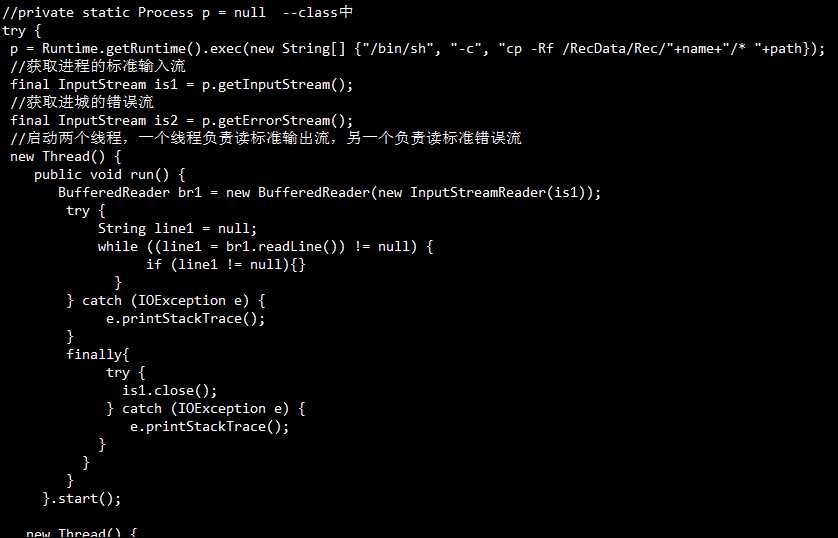Java中RunTime類介紹
Runtime 類代表著Java程序的運行時環境,每個Java程序都有一個Runtime實例,該類會被自動創建,我們可以通過Runtime.getRuntime() 方法來獲取當前程序的Runtime實例。
獲取當前Jvm的內存信息
/* * 獲取當前jvm的內存信息,返回的值是 字節為單位 * */ public static void getFreeMemory() { //獲取可用內存 long value = Runtime.getRuntime().freeMemory(); System.out.println("可用內存為:"+value/1024/1024+"mb");//獲取jvm的總數量,該值會不斷的變化 long totalMemory = Runtime.getRuntime().totalMemory(); System.out.println("全部內存為:"+totalMemory/1024/1024+"mb"); //獲取jvm 可以最大使用的內存數量,如果沒有被限制 返回 Long.MAX_VALUE; long maxMemory = Runtime.getRuntime().maxMemory(); System.out.println("可用最大內存為:"+maxMemory/1024/1024+"mb"); }
獲取jvm可用的處理器核心的數量
一般可以和newFixedThreadPool一起使用
/* * 獲取jvm可用的處理器核心的數量 * */ public static void getAvailableProcessors() { int value = Runtime.getRuntime().availableProcessors(); System.out.println(value);
ExecutorService fixedThreadPool = Executors.newFixedThreadPool(Runtime.getRuntime().availableProcessors()); }
執行系統命令
RunTime.getRuntime().exec()的構造方法
public Process exec(String command)-----在單獨的進程中執行指定的字符串命令。 public Process exec(String [] cmdArray)---在單獨的進程中執行指定命令和變量 public Process exec(String command, String [] envp)----在指定環境的獨立進程中執行指定命令和變量 public Process exec(String [] cmdArray, String [] envp)----在指定環境的獨立進程中執行指定的命令和變量 public Process exec(String command,String[] envp,File dir)----在有指定環境和工作目錄的獨立進程中執行指定的字符串命令 public Process exec(String[] cmdarray,String[] envp,File dir)----在指定環境和工作目錄的獨立進程中執行指定的命令和變量
Process的幾種方法
1.destroy():殺掉子進程
2.exitValue():返回子進程的出口值,值 0 表示正常終止
3.getErrorStream():獲取子進程的錯誤流
4.getInputStream():獲取子進程的輸入流
5.getOutputStream():獲取子進程的輸出流
6.waitFor():導致當前線程等待,如有必要,一直要等到由該Process對象表示的進程已經終止。如果已終止該子進程,此方法立即返回。如果沒有終止該子進程,調用的線程將被阻塞,直到退出子進程,根據慣例,0 表示正常終止
註意:在java中,調用runtime線程執行腳本是非常消耗資源的,所以切忌不要頻繁使用!
在調用runtime去執行腳本的時候,其實就是JVM開了一個子線程去調用JVM所在系統的命令,其中開了三個通道:輸入流、輸出流、錯誤流,其中輸出流就是子線程走調用的通道。
大家都知道,waitFor是等待子線程執行命令結束後才執行, 但是在runtime中,打開程序的命令如果不關閉,就不算子線程結束。比如以下代碼。
private static Process p = null; p = Runtime.getRuntime().exec("notepad.exe"); p.waitFor(); System.out.println("-------------------我被執行了-------------------");
以上代碼中,打開windows中記事本。如果我們不手動關閉記事本,那麽輸出語句就不會被執行,這點是需要理解的。
process的阻塞
在runtime執行大點的命令中,輸入流和錯誤流會不斷有流進入存儲在JVM的緩沖區中,如果緩沖區的流不被讀取被填滿時,就會造成runtime的阻塞。所以在進行比如:大文件復制等的操作時,我們還需要不斷的去讀取JVM中的緩沖區的流,來防止Runtime的死鎖阻塞。 代碼:linux中拷貝文件防止阻塞的寫法

打開記事本
Runtime.getRuntime().exec("notepad.exe");
打開某個文件(不管是word還excel等等文件)
Runtime.getRuntime().exec("cmd /c start " + "\"\" \"" + path + "\"");
打開ie瀏覽器
Runtime.getRuntime().exec("C:\\Program Files\\Internet Explorer\\IEXPLORE.EXE");
得到系統的環境變量
@Test public void dirRuntimeProcess() throws IOException, InterruptedException { Process process = Runtime.getRuntime().exec("cmd.exe /c echo %JAVA_HOME%"); BufferedReader bufferedReader = new BufferedReader(new InputStreamReader(process.getInputStream())); String string = null; while ((string = bufferedReader.readLine()) != null) { System.out.println(string); // D:\Java\jdk\jdk1.8.0_152 } process.waitFor(); System.out.println("return: " + process.exitValue()); // return: 0 }
得到java的版本號,這個和上述的不一樣
@Test public void getJavaVersion() { try { Process process = Runtime.getRuntime().exec("javac -version"); BufferedReader br = new BufferedReader(new InputStreamReader(process.getErrorStream())); String line = null; while ((line = br.readLine()) != null) System.out.println(line); // javac 1.8.0_152 process.waitFor(); System.out.println("Process exitValue: " + process.exitValue()); } catch (Throwable t) { t.printStackTrace(); } }
執行外部命令得到的結果
@Test public void execProgramC() { try { Process process = Runtime.getRuntime().exec("C:/Users/76801/Desktop/huhx.exe"); BufferedReader br = new BufferedReader(new InputStreamReader(process.getInputStream())); String line = null; while ((line = br.readLine()) != null) System.out.println(line); // Hello World. process.waitFor(); System.out.println("Process exitValue: " + process.exitValue()); } catch (Throwable t) { t.printStackTrace(); } }
huhx.c比較簡單,就是打印一句話。
#include<stdio.h> void main() { printf("Hello World."); }
導出mysql腳本
@Test public void execMysqldump() throws IOException, InterruptedException { String execCommand = "cmd c/ D:/Java/mysqldump.exe -uhuhx -phuhx boot_learn > D:/bootlearn.sql"; System.out.println("exec command: " + execCommand); Runtime runtime = Runtime.getRuntime(); Process p = runtime.exec(execCommand); StreamGobbler errorGobbler = new StreamGobbler(p.getErrorStream(), "Error"); StreamGobbler outputGobbler = new StreamGobbler(p.getInputStream(), "Output"); errorGobbler.start(); outputGobbler.start(); p.waitFor(); System.out.println("successful." + p.exitValue()); }
上述也使用到了網上所說的讀出窗口的標準輸出緩沖區中的內容,仍舊沒有解決Process的waitFor阻塞問題。下面是清空緩沖區的線程代碼:
public class StreamGobbler extends Thread { InputStream is; String type; public StreamGobbler(InputStream is, String type) { this.is = is; this.type = type; } public void run() { try (InputStreamReader isr = new InputStreamReader(is);) { BufferedReader br = new BufferedReader(isr); String line = null; while ((line = br.readLine()) != null) { if (type.equals("Error")) { System.out.println("Error :" + line); } else { System.out.println("Debug:" + line); } } } catch (IOException e) { e.printStackTrace(); } } }
代碼的目標是導出mysql數據庫的腳本。沒有找到問題的解決方案,運行環境是win10,jdk1.8。
在JVM中增加一個關閉的鉤子
閱讀ElasticSearch的源碼時,BootStrap類中調用了Runtime.getRuntime().addShutdownHook方法。接下來對java.lang包中的Runtime類的addShutdownHook方法進行說明。
這個方法的意思就是在JVM中增加一個關閉的鉤子,當JVM關閉的時候,會執行系統中已經設置的所有通過方法addShutdownHook添加的鉤子,當系統執行完這些鉤子後,JVM才會關閉。所以這些鉤子可以在JVM關閉的時候進行內存清理、對象銷毀等操作。
為了更清晰的說明,編寫如下程序:
public class TestShutdownHook { public static void main(String[] args) { // thread1 Thread thread1 = new Thread() { public void run() { System.out.println("thread1"); } }; // thread2 Thread thread2 = new Thread() { public void run() { System.out.println("thread2"); } }; // shutdownThread Thread shutdownThread = new Thread() { public void run() { System.out.println("shutdownThread"); } }; Runtime.getRuntime().addShutdownHook(shutdownThread); thread1.start(); thread2.start(); } }
輸出結果:
thread1
thread2
shutdownThread
或
thread2
thread1
shutdownThread
無論是先打印thread1還是thread2,shutdownThread 線程都是最後執行的(因為這個線程是在JVM執行關閉前才會執行)。
關閉JVM程序
Runtime的exit表示的關閉JVM程序,但是不釋放內存,舉例:
System.exit(0);//表示正常程序的關閉,執行的是以下操作: public static void exit(int status) { Runtime.getRuntime().exit(status); }
備註:如果是 0表示正常關閉,如果是非0表示異常關閉,如果想釋放內存的話,用“dispose()”關閉當前程序,並釋放資源。
System.exit()的內部實現也是Runtime.getRuntime().exit();
Java中RunTime類介紹
